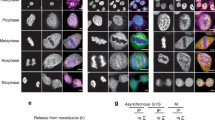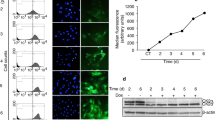Abstract
The chromodomain helicase DNA-binding (CHD) family of enzymes is thought to regulate gene expression, but their role in the regulation of specific genes has been unclear. Here we show that CHD8 is expressed at a high level during early embryogenesis and prevents apoptosis mediated by the tumour suppressor protein p53. CHD8 was found to bind to p53 and to suppress its transactivation activity. CHD8 promoted the association of p53 and histone H1, forming a trimeric complex on chromatin that was required for inhibition of p53-dependent transactivation and apoptosis. Depletion of CHD8 or histone H1 resulted in p53 activation and apoptosis. Furthermore, Chd8−/− mice died early during embryogenesis, manifesting widespread apoptosis, whereas deletion of p53 ameliorated this developmental arrest. These observations reveal a mode of p53 regulation mediated by CHD8, which may set a threshold for induction of apoptosis during early embryogenesis by counteracting p53 function through recruitment of histone H1.
This is a preview of subscription content, access via your institution
Access options
Subscribe to this journal
Receive 12 print issues and online access
$209.00 per year
only $17.42 per issue
Buy this article
- Purchase on Springer Link
- Instant access to full article PDF
Prices may be subject to local taxes which are calculated during checkout








Similar content being viewed by others
References
Vousden, K. H. & Lu, X. Live or let die: the cell's response to p53. Nature Rev. Cancer 2, 594–604 (2002).
Harris, S. L. & Levine, A. J. The p53 pathway: positive and negative feedback loops. Oncogene 24, 2899–2908 (2005).
Vogelstein, B., Lane, D. & Levine, A. J. Surfing the p53 network. Nature 408, 307–310 (2000).
Laptenko, O. & Prives, C. Transcriptional regulation by p53: one protein, many possibilities. Cell Death Differ. 13, 951–961 (2006).
Aylon, Y. & Oren, M. Living with p53, dying of p53. Cell 130, 597–600 (2007).
Toledo, F. & Wahl, G. M. Regulating the p53 pathway: in vitro hypotheses, in vivo veritas. Nature Rev. Cancer 6, 909–923 (2006).
Lavin, M. F. & Gueven, N. The complexity of p53 stabilization and activation. Cell Death Differ. 13, 941–950 (2006).
Zhang, Y. & Xiong, Y. A p53 amino-terminal nuclear export signal inhibited by DNA damage-induced phosphorylation. Science 292, 1910–1915 (2001).
Tanaka, T., Ohkubo, S., Tatsuno, I. & Prives, C. hCAS/CSE1L associates with chromatin and regulates expression of select p53 target genes. Cell 130, 638–650 (2007).
Das, S. et al. Hzf Determines cell survival upon genotoxic stress by modulating p53 transactivation. Cell 130, 624–637 (2007).
Lee, D. et al. SWI/SNF complex interacts with tumor suppressor p53 and is necessary for the activation of p53-mediated transcription. J. Biol. Chem. 277, 22330–22337 (2002).
Kim, K. et al. Isolation and characterization of a novel H1.2 complex that acts as a repressor of p53-mediated transcription. J. Biol. Chem. 283, 9113–9126 (2008).
Becker, P. B. Nucleosome remodelers on track. Nature Struct. Mol. Biol. 12, 732–733 (2005).
Marfella, C. G. & Imbalzano, A. N. The Chd family of chromatin remodelers. Mutat. Res. 618, 30–40 (2007).
Hall, J. A. & Georgel, P. T. CHD proteins: a diverse family with strong ties. Biochem. Cell Biol. 85, 463–476 (2007).
Pray-Grant, M. G., Daniel, J. A., Schieltz, D., Yates, J. R., 3rd & Grant, P. A. Chd1 chromodomain links histone H3 methylation with SAGA- and SLIK-dependent acetylation. Nature 433, 434–438 (2005).
Zhang, L., Schroeder, S., Fong, N. & Bentley, D. L. Altered nucleosome occupancy and histone H3K4 methylation in response to 'transcriptional stress'. EMBO J. 24, 2379–2390 (2005).
Flanagan, J. F. et al. Double chromodomains cooperate to recognize the methylated histone H3 tail. Nature 438, 1181–1185 (2005).
Lusser, A., Urwin, D. L. & Kadonaga, J. T. Distinct activities of CHD1 and ACF in ATP-dependent chromatin assembly. Nature Struct. Mol. Biol. 12, 160–166 (2005).
Sakamoto, I. et al. A novel β-catenin-binding protein inhibits β-catenin-dependent Tcf activation and axis formation. J. Biol. Chem. 275, 32871–32878 (2000).
Ishihara, K., Oshimura, M. & Nakao, M. CTCF-dependent chromatin insulator is linked to epigenetic remodeling. Mol. Cell 23, 733–742 (2006).
Nishiyama, M. et al. Early embryonic death in mice lacking the β-catenin-binding protein Duplin. Mol. Cell. Biol. 24, 8386–8394 (2004).
Fan, Y. et al. Histone H1 depletion in mammals alters global chromatin structure but causes specific changes in gene regulation. Cell 123, 1199–1212 (2005).
Funayama, R., Saito, M., Tanobe, H. & Ishikawa, F. Loss of linker histone H1 in cellular senescence. J. Cell Biol. 175, 869–880 (2006).
Vignali, M. & Workman, J. L. Location and function of linker histones. Nature Struct. Biol. 5, 1025–1028 (1998).
Thomas, J. O. Histone H1: location and role. Curr. Opin. Cell Biol. 11, 312–317 (1999).
Lusser, A. & Kadonaga, J. T. Strategies for the reconstitution of chromatin. Nature Methods 1, 19–26 (2004).
Thoma, F., Koller, T. & Klug, A. Involvement of histone H1 in the organization of the nucleosome and of the salt-dependent superstructures of chromatin. J. Cell Biol. 83, 403–427 (1979).
Bednar, J. et al. Nucleosomes, linker DNA, and linker histone form a unique structural motif that directs the higher-order folding and compaction of chromatin. Proc. Natl Acad. Sci. USA 95, 14173–14178 (1998).
Pennings, S., Meersseman, G. & Bradbury, E. M. Linker histones H1 and H5 prevent the mobility of positioned nucleosomes. Proc. Natl Acad. Sci. USA 91, 10275–10279 (1994).
Shimamura, A., Sapp, M., Rodriguez-Campos, A. & Worcel, A. Histone H1 represses transcription from minichromosomes assembled in vitro. Mol. Cell. Biol. 9, 5573–5584 (1989).
Laybourn, P. J. & Kadonaga, J. T. Role of nucleosomal cores and histone H1 in regulation of transcription by RNA polymerase II. Science 254, 238–245 (1991).
Shen, X., Yu, L., Weir, J. W. & Gorovsky, M. A. Linker histones are not essential and affect chromatin condensation in vivo. Cell 82, 47–56 (1995).
Ushinsky, S. C. et al. Histone H1 in Saccharomyces cerevisiae. Yeast 13, 151–161 (1997).
Patterton, H. G., Landel, C. C., Landsman, D., Peterson, C. L. & Simpson, R. T. The biochemical and phenotypic characterization of Hho1p, the putative linker histone H1 of Saccharomyces cerevisiae. J. Biol. Chem. 273, 7268–7276 (1998).
Ramon, A., Muro-Pastor, M. I., Scazzocchio, C. & Gonzalez, R. Deletion of the unique gene encoding a typical histone H1 has no apparent phenotype in Aspergillus nidulans. Mol. Microbiol. 35, 223–233 (2000).
Rupp, R. A. & Becker, P. B. Gene regulation by histone H1: new links to DNA methylation. Cell 123, 1178–1179 (2005).
Wang, S. & El-Deiry, W. S. p73 or p53 directly regulates human p53 transcription to maintain cell cycle checkpoints. Cancer Res. 66, 6982–6989 (2006).
Takagi, M., Absalon, M. J., McLure, K. G. & Kastan, M. B. Regulation of p53 translation and induction after DNA damage by ribosomal protein L26 and nucleolin. Cell 123, 49–63 (2005).
Zahir, F. et al. Novel deletions of 14q11.2 associated with developmental delay, cognitive impairment and similar minor anomalies in three children. J. Med. Genet. 44, 556–561 (2007).
Nakayama, K. et al. Mice lacking p27Kip1 display increased body size, multiple organ hyperplasia, retinal dysplasia, and pituitary tumors. Cell 85, 707–720 (1996).
Nakayama, K. et al. Targeted disruption of Skp2 results in accumulation of cyclin E and p27Kip1, polyploidy and centrosome overduplication. EMBO J. 19, 2069–2081 (2000).
Kamura, T. et al. VHL-box and SOCS-box domains determine binding specificity for Cul2-Rbx1 and Cul5-Rbx2 modules of ubiquitin ligases. Genes Dev. 18, 3055–3065 (2004).
Natsume, T. et al. A direct nanoflow liquid chromatography-tandem mass spectrometry system for interaction proteomics. Anal. Chem. 74, 4725–4733 (2002).
Yada, M. et al. Phosphorylation-dependent degradation of c-Myc is mediated by the F-box protein Fbw7. EMBO J. 23, 2116–2125 (2004).
Acknowledgements
We thank T. Kitamura for pMX-puro; J. M. Cunningham and K. Hanada for the mCAT-1 plasmid; S. Miyake for the PG13-, p21-, and p21 mutant–Luc plasmids; T. Takemori for the NF-κB Luc plasmid; F. Ishikawa and R. Funayama for the N-fusion and C-fusion plasmids; M. Kitagawa for HCT116 and SaOS2 cells; M. Sato, Y. Yamada, T. Moroishi, Y. Katayama, N. Nishimura and K. Oyamada for technical assistance; M. Kimura and A. Ohta for help with preparation of the manuscript; and T. Ushijima, K. Hayashi and members of the authors' laboratories for discussion. K.I.N. was supported by Takeda Science Foundation. Y.F. and A.I.S. were supported by NIH grant CA79057. Y.F. is a GCC Cancer Scholar supported by Georgia Cancer Coalition.
Author information
Authors and Affiliations
Contributions
M.N. performed and planned all experiments, except some of ChIP and co-immunoprecipitation experiments, which were performed by K.O., Y.T. and T. Nakagawa; K.I.N. coordinated the study, oversaw the results and wrote the manuscript; S.I. and T. Natsume contributed to proteomic analysis; Y.F. and A.I.S. provided histone H1 triple-knockout cells and many suggestions; A.K. provided antibodies to CHD8. All authors discussed the results and commented on the manuscript.
Corresponding author
Ethics declarations
Competing interests
The authors declare no competing financial interests.
Supplementary information
Supplementary Information
Supplementary Information (PDF 1606 kb)
Rights and permissions
About this article
Cite this article
Nishiyama, M., Oshikawa, K., Tsukada, Yi. et al. CHD8 suppresses p53-mediated apoptosis through histone H1 recruitment during early embryogenesis. Nat Cell Biol 11, 172–182 (2009). https://doi.org/10.1038/ncb1831
Received:
Accepted:
Published:
Issue Date:
DOI: https://doi.org/10.1038/ncb1831
This article is cited by
-
Deletion of the autism-related gene Chd8 alters activity-dependent transcriptional responses in mouse postmitotic neurons
Communications Biology (2023)
-
iPSC toolbox for understanding and repairing disrupted brain circuits in autism
Molecular Psychiatry (2022)
-
Developmental pyrethroid exposure and age influence phenotypes in a Chd8 haploinsufficient autism mouse model
Scientific Reports (2022)
-
The phenotypic spectrum and genotype-phenotype correlations in 106 patients with variants in major autism gene CHD8
Translational Psychiatry (2022)
-
Distinct, dosage-sensitive requirements for the autism-associated factor CHD8 during cortical development
Molecular Autism (2021)



